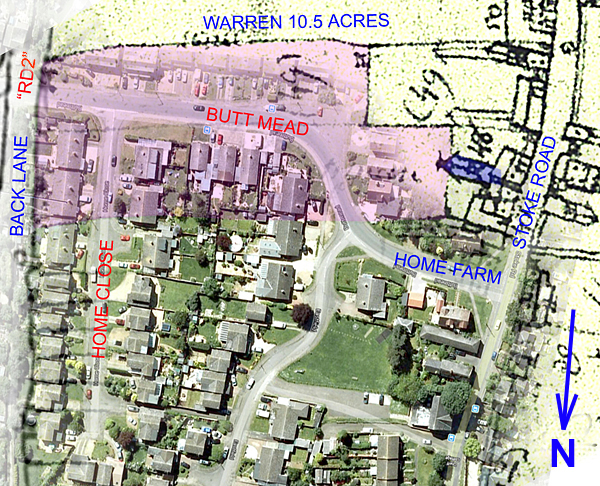|
The
Stone Head at Blisworth and the Blands Tony
Marsh, Blisworth
Introduction The subject of this paper is a large carved stone head (in two parts) which was discovered in Blisworth, Northamptonshire, in 1960 during the modernisation of a stone house. The back faces of the head carry a carved relief inscription, R B 1652. When installed in the long south wall of the house, the inscription indicated that R B built the house in 1652 while the face of the carved head had been hidden, since then, embedded within the fabric of the wall for more than 300 years. The mantle-beam over a fireplace in the house also displays the date 1652. The late George Freeston (Blisworth local historian) contacted the British Museum and also Alan MacCormick from Leicester Museum, and was informed that the carved head was probably obtained from Holdenby House, Northamptonshire. This was evident in terms of style whilst the date coincided with the period over which the original palace at Holdenby was known to have been demolished, ie. 1651 – 1656. This paper aims to give an account of some of the events of the Civil War, including the fate of Holdenby House, and how these affected Blisworth in general and one resident of Blisworth in particular, namely Richard Bland (the “R B”), soldier in Oliver Cromwell’s anti-Royalist army. It was Alan MacCormick1 who sparked off a renewed interest in the carved head when he contacted the Blisworth Heritage Society in 2013. Details of House and Carving The house in Stoke Road, Blisworth, consists of a single ridge which runs east-west with a fireplace that is contemporary with the main structure placed at the western end. Memory of the exact installed position of the date-stones is lost but it is recalled, uncertainly, as “over the door on the south wall”. A window now takes centre position in that wall and over its lintel are some slightly different coloured sandstone blocks that bear less weather-erosion at their joints than blocks elsewhere. A reasonable supposition is that the door was framed by an added stone decorative lintel supported on columns of some sort and that the date was displayed above that lintel. The date and initials are shown in the heading pictures. The character ‘5’ is carved as a small serpent consistent with the vernacular of that era. Evidently the block work generally has been subject to various phases of rebuilding and re-pointing and records show that the house was once divided into three dwellings that were let separately by the Duke of Grafton, in Victorian times. Despite the changes, there is an even row of blocks at the level of the sills of new upstairs windows and this suggests the location of the eaves line when roofed with thatching. Whether there was once a corridor from a south door to another door on the north side is difficult to ascertain but seems likely. The house was slated by 19192 and was completely re-roofed in 1960 using concrete tiles on timber trusses. The main interest in the date-stones is of course the finely carved head shown in the heading pictures. From those consulted in the 1960s was the opinion that the carving was probably from Holdenby House, built by Sir Christopher Hatton in 1583. It was known that many tons of stone from the demolition of the origin palace at Holdenby were sold off in 1651 onwards which would explain availability but there has to be a reason why some ordinary pieces of limestone were not used instead to display the date of this house.
Alan MacCormick writes that the carved head represents a period in decoration in England when foreign influence and craftsmen were still dominant, for example Cornelis Floris and Ullysis Aldovandi, and home-grown artists had not yet achieved the same competence. Who the local craftsmen were, their patrons and where they worked as well as whether their influence was passed on is of importance. A notable feature of the carving is the mask covering part of the face. Where is a parallel to this to be found elsewhere? Local buildings experts3 have recently considered the carving and judge it a fine example of Renaissance work that certainly dates from the 16th century. Bailey4 states there are mid-sixteenth century chimneypieces carved from clunch at Boughton House and Apethorpe Hall and while these are purely architectural there are some similarities with this head, especially in the case of the chimneypiece in the Audit Room at Boughton. There are also a pair of grotesque carved wooden heads in Holdenby Church that are known to have originated in Holdenby House with some similarity in the detailing and thought to be by Hollemans. Arising from other possibilities there has been no success; the ex-Holdenby fireplace at Coton Manor bears no resemblances and all three of the town houses5 built in Northampton with stones and worked pieces, one each in Gold St., Saint Giles St. and The Drapery, were all taken down in the 1840s and 1850s and replaced with more ‘fashionable’ Victorian elevations. The carved mask, which half covers the face, may be regarded as a version of the Colombina mask that is thought to have been invented in Italy at the beginning of the 16C. To hold mask balls was common in 16C high society. This carving is rather grotesque; the man with his old-looking nose and sad eyes seems to represent either frustration or sufferance. With other, related, carvings in a high frieze around a hall that was dedicated to entertainment, a painted and gilded array of them would have conveyed a decorative medley of emotions.
The Dutch carver Garrett Hollemans has been associated with Holdenby House. Apparently he always dated his work but nothing has been found dated earlier than 15846. It is interesting to note that Holdenby House was completed in1583. Since there is no record of when Hollemans came to England and, as Holdenby House was demolished in 1651, there is nothing left to confirm that the building contained some of Hollemans earlier work, either dated or undated. He must have been quite elderly by 1595, having acquired the nickname "Father Garrett", so it seems reasonable to suppose there was an early part of his career that has left little trace. Bayliss notes, unfortunately without giving examples, that popular stones were "various freestones, some particularly white and able to take detail" (ie. clunch?) However the majority of church shrines by Hollemans were carved in alabaster. Richard Bland (1625 – 1675) There is only one candidate R.B. to be found in the Blisworth church records of births, marriages and deaths that matches the date and that is Richard Bland 1625 - 1675. He is evidently the grandson of a George Bland, yeoman who died in 1624. This earliest Bland we have on record is the George who was one of the signatories to a document, in Latin, dated 1617, that proclaimed the status of many strips or lands that were communally cultivated for the good of Church upkeep and for the poor of the parish. Some details are absent but it is evident that Richard Bland's father was a second George. As with most families of this era there is no information on where the Blands lived. That is the case until Grafton rent survey maps make it clear that in 1727 a Bland lived at this house in the Stoke road indicating correctly the orientation of the house with a yard area set back from the road, as it is now. The following section of the Bland tree should explain the links: Bland: Richard Bland (~1700 – 1761) definitely lived at the house and thus we can link our candidate R.B. with the same house, in terms of family, with the assumption that a house had become the "seat" of the family over many generations. This of course was very often the case even where the property was rented from a Lord of the Manor. There follows a tabulation of dates through the lifetime of Richard Bland. Richard
Bland: Bland and the Parliamentary Army
In the research for this account it seemed appropriate to look for evidence of Richard Bland being in Cromwell’s army. This was based on a supposition that a likely act by a Roundhead soldier might be, with insult in mind, to set embedded and hidden in a wall some carving of Royalist origins. In fact, Richard Bland was found recruited in the first formation of the independent army, namely; Lord Wharton's army intended for Ireland in June 1642, which never proposed serving against the King's person in England but, rather, was formed to fight the insurgence in Ireland. According to parliamentary
records7 this army consisted of 5000 foot soldiers and 500 mounted (cavalry) men. The former were grouped into seven companies with a command structure based on an ensign, corporals, a lieutenant and a captain of each. In June 1642 two of the ensigns were Oliver Cromwell himself and Richard Bland and a third was Oliver St John, a long time close friend of Cromwell’s. There seems little doubt that Cromwell had shrewdly positioned himself in the command as a lowly ensign (ie. banner bearer) to facilitate motivation of the men. Another individual of importance was Adam Baynes who
initially took the position of lieutenant in one of the companies. With his grasp of financial matters he later rose to brief eminence and influence in the government of the 1650s. Adam Baynes and Holdenby Baynes actually took possession of Holdenby Palace in 1651 and promptly proceeded to demolish it. It is a reasonable supposition that, if the carved head at Blisworth really originated in that palace then it was Richard Bland who effected its removal at some opportunity in the period 1649 to 1651, probably with the approval of Adam Baynes. Thus it is supposed that he obtained a small token of royalist opulence (a deeply cracked carved head) and his act in 1652 of burying the fine Royalist carving in a wall, marking his personal achievement, could be seen as a defiant but satisfactory culmination of a period of fighting, unpaid and while sometimes half-starved, during which he must have seen many friends perish. Maybe he possessed a political appreciation and also was in a celebratory mood, looking forward to a new republican era. At Holdenby, Baynes was busy in demolition. The grandeur of the palace is indicated by a contemporary writer who was referenced by Dicey11 in a booklet on county history published in 1878 by the Northampton Mercury. The source was Norden (estate surveyor, 1547–1625) who wrote, “a very beautiful building erected with such uniformity and so answerably contrived as for the quantity and quality is not to be matched in this land. In the hall there are raised three pyramids, one very high standing, instead of a shrine that ascended to the roof of the hall, the other two pyramids were made one with the side walls of the same hall, and on them are depicted the arms of all the gentlemen of the same shire, and of all the noblemen of this land.” Evidently there seems to be architectural scope for a high frieze decorated with various carved heads, indeed one particular carved head, if seen in situ by Bland, might have been associated with a disliked nobleman. Norden continues to describe the setting in the park, mounted on a hill, a grand building with divers walks, fish pools, fruit tree plantings and arbours. He later concluded in declaring the site so beautiful that it may well delight a prince. In any event Adam Baynes had planned big changes at Holdenby. He built a new and smaller building but retained a kitchen wing from the old structure and one fine arch was re-erected and dated 1659. Baynes must have used a small army of workers, perhaps literally a band of his ex-soldiers who would get paid and regular feeding. There must have been tons of surplus stone, the majority being Weldon stone (fine oolitic) with some clunch (Tottenhoe or similar) for use internally. In an 1886 account5 it was stated that £3500 worth of stone was sold, much of it as decorative pieces. Records are sparse so it is hard to say how many grand stately houses in the area benefited from this. After a King was restored to the throne in 1660, Baynes was evicted from Holdenby and briefly imprisoned. He came very close to being executed for treason12 and so adopted a very low profile lifestyle in Teeton, Northamptonshire. He was again imprisoned in 1666 but again managed to avoid the criminal charges. Baynes’s considerable business skills were vital in brokering financial settlements for soldiers, but perhaps like some of our 21C bankers, he may have been seen to slice off too much for himself. The Interregnum and Blisworth In September 1658 Cromwell died and the government fell into disarray. Great confusion ensued as the King, Charles II, reclaimed his assets in 1660 that were held by villagers, soldiers and speculators. This marked the end of an Interregnum (1649 – 1660) period. It appears that a key decision was made to try and retain the current ‘owners’ at a negotiated rent so that they might continue to farm the land. It seems obvious that this would provide immediate income and, probably, promote a much greater income than would have been possible had the land management reverted entirely to strip farming. This last point is borne out by what is described as “improved value” in the document that summarised the 1660 rent survey13 for Blisworth.
By the time of the Grafton rent survey of 172714 the total area in tenancies was 1690 acres matching quite closely the parish area at 1890 acres, especially in view of the fact that much woodland in the south of the parish was being gradually cleared. The survey and mapping15 show that ~850 acres remained as ‘common land’ (ie. not enclosed and with rights for open field grazing after harvest) but this area included 600 acres that were held in tenancies by as few as 10 farmers. Such holdings were probably blocks of lands likely to be enclosed in due course. The Duke of Grafton evidently thought those in the village with very little land had sufficient means, for he (or rather his grandson) waited until the Parliamentary final enclosures of the early 19th century before introducing sizeable allotments that were administered by the Rector. In 1660 Richard Bland is recorded holding only three acres, with no house, for which he paid annually £1 10s. 0d. The three acres can be identified today as the paddock that lay behind numbers 31 through 37 inclusive in the Stoke Road (see below), before 1960s housing development. Rent surveys may be assumed to only included assets that generated any income. Hence, if Richard Bland owned a house that he had built during the Interregnum on land that he then owned, it is arguable that the managers of the Grafton estate would not charge him rent for the house, which would remain Bland’s property, and the existence of the house would be omitted from the survey. Thus, a reasonable supposition is that Bland was one of very few freeholders in Blisworth because he had invested his army pay in an unusual way; that of paying for house building. He lived only another fifteen years in this relative financial comfort. There is no record of his professional pursuits while his elder brother by two years, William Bland, farmed a tenancy of 53 acres in 1660 and would be expected to be quite prosperous, though lacking the memories and tales of a decade of army life. The hearth tax records of 1674 show 5 hearths at two Bland households and this is interpreted as 2 hearths for the house of this study and 3 in a second house occupied by brother William. The restoration of Crown Lands to the King regenerated the same problem in paying some soldiers their arrears. The aforementioned Commissioners’ work therefore continued as the value of confiscated purchased land was repaid to soldiers over a period that extended through to the 1670s and two rounds of a pole tax were raised to supply the funds. Bland’s Will and Unsolved Riddles Bland died in 1675 and left a Will (N.R.O.) Despite the carving of a 1652 date, together with hearts, on the mantle-beam over the fireplace he mentioned no wife and there is no record of any marriage or death of a spouse in the parish records. He left everything to a Charles including “my house worth £40 and ye land that goes with it” and there is usual detail – “a horse, a few piggs and two old cows and all the other implements about the house and yard”. The beneficiary was very likely Charles Bland who died in Blisworth parish in 1683. He was probably a cousin who may have been born in a neighbouring parish but moved into Richard’s house at some point. The yard referred to is in evidence today. The implication of the Will is that Richard Bland’s house was transferred freehold to Charles. In subsequent transactions one would expect the property to remain as freehold. However, in the 1727 Grafton rent survey, Richard Bland (~1700 – 1761, yeoman and grand-nephew) has a tenancy of 26 acres of pasture and a half-share of a plot of one acre and only a tenancy in the house that was owned by his grand-uncle in the Interregnum. The 26 acres are mostly scattered near the Tiffield parish border, interestingly intermingled with fields rented by the Brayfields, in Wolfey Common and the Gully Pieces. Regarding Bland's house, evidently the Duke of Grafton, owner of the Honour of Grafton since 1663, had stepped in to claim it. There is the possibility of an arrangement made after the Interregnum for Bland to own the house for ‘two lives’ and that would explain the change. However there is no known Deed for this arrangement and so this remains unresolved. Many Grafton records are known to be lost owing to a fire at Euston House. Acknowledgements: Sally Edwards helped by checking the church records, including those of neighbouring parishes and Alan MacCormick has made many important points aimed to expand as far as possible the provenance of the carving including his photographs obtained at Holdenby. Otherwise, the information obtained was, in the main, garnered through the internet and from a CD based on N.R.O. records16. Footnote:
The Plowman house is identified later, in 1718, by Curate Bullyer in
reporting to William Taylor who was acquiring information for the
publication Bridges' History of Northamptonshire. He stated his
belief that "it was formerly the
dwelling house of Sir Robert Wake, who owned the whole town: 'Tis now
upon ye De of Grafton hold". The last Wake was actually a Roger (d.
1504) but aside from that it is clear that the original Manor was
thought to be in the plot behind the Church and not opposite in
the High Street. -----------------------------------------------------------------------------------------------------
In April 2013 I learnt of the stone head re-discovery from Ray Andrews at one of the BHS meetings. Out of mild interest I searched the birth, deaths and marriage records that have been recently collected on this website and discovered only the surnames Bland and Brayfield, to fit "B" for Blisworth at the time, ie. c1600 - 1700. Although a Brayfield was not discounted (bearing in mind an incomplete record) the name Richard Bland happened to be the only fit with the initials RB that were carved as a date-stone. While I was searching the internet for the history of Holdenby House, because it had been suggested through George Freeston's contacts in the 1960s, it was impressed upon me that it had been a Royalist stronghold (Sir C. Hatton etc) that was confiscated by Cromwell's army around 1644 and later was the place Charles I was imprisoned for a year before his execution. With that stimulus I searched for "Bland, Army" in Google and found Richard Bland had been an anti-Royalist for a few years ( 642fac.pdf ), rose to the rank of Captain under Fairfax, was an Ensign foot-soldier in the early days with Cromwell and probably knew Adam Baynes, who was a chief within the Army who had appropriated Holdenby House for his own use from 1650 onwards. With Richard Bland thus considered to be the very likely candidate as the builder (or purchaser) of the house in Blisworth, I filled in some family history and re-read the article by Gentles about the Crown Sales and found Adam Baynes name as a member of the Commission in charge of the Sales. I could never have found proof that Richard Bland carried the stone head from Holdenby to Blisworth but I did discover, in November 2013, his purchase of a few acres of land in Blisworth as recorded in a document kept at the National Archive, Kew. There were now "enough bricks in the wall" to feel justified in speculating over a few of the details, for example, Bland's retained tenancy in 1660 of 3 acres I suppose was located directly behind his house, stretching up the slopes to the Back Lane. The mapped layout of the fields, see below, would be subject to the warps in trying to match a 1727 line drawing with Google-Earth reality but, bearing in mind that field-scope tends to survive the centuries, the S-bend of Buttmead seems to make best use of the area of the farm fields that remained in the 1960s and, at this stage, enough is enough in re-constructing the layout. We cannot do better, for ancient Deeds seem never to have any maps with them but instead those named in the agreement are referred to "being altogether" in relation to the details and the trust between them.
|
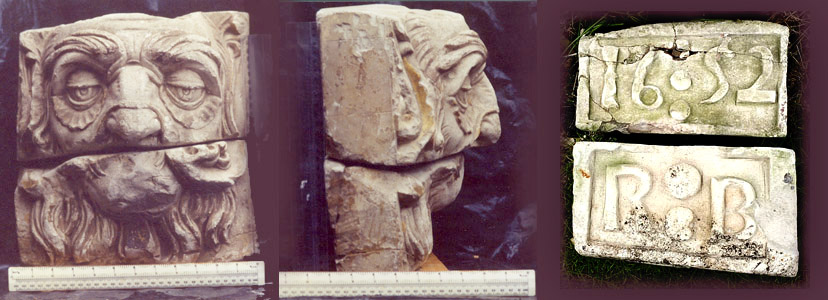
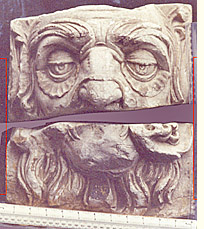 The stone of the carving is “clunch”, a fine white stone that is generally found internally in buildings on account of its relative softness compared to other limestones. The nearest source is Tottenhoe in Bedfordshire. Recalled from the 1960s is the fact that there were traces of gilding and red and green paint on the carving. The head is broken into two pieces that defy being fitted together but by re-aligning the halves in a computer image, see
inset, it appears that a quite thick intermediate layer is missing altogether, taking a carved mouth for the head with it. With lightly scored guide marks, placed by the mason, on the sides of the blocks, the whole work is 11.5 inches wide and this size suggests it must have been placed high in a room or corridor.
The high positioning is further suggested by the slight downward tilt of
the face (as viewed from the side).
The stone of the carving is “clunch”, a fine white stone that is generally found internally in buildings on account of its relative softness compared to other limestones. The nearest source is Tottenhoe in Bedfordshire. Recalled from the 1960s is the fact that there were traces of gilding and red and green paint on the carving. The head is broken into two pieces that defy being fitted together but by re-aligning the halves in a computer image, see
inset, it appears that a quite thick intermediate layer is missing altogether, taking a carved mouth for the head with it. With lightly scored guide marks, placed by the mason, on the sides of the blocks, the whole work is 11.5 inches wide and this size suggests it must have been placed high in a room or corridor.
The high positioning is further suggested by the slight downward tilt of
the face (as viewed from the side).
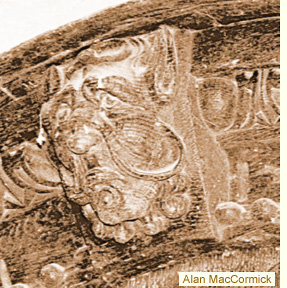 There is an interesting style similarity in the detailing with the small wooden carving at the top of a 16C wooden roundel now being used in Holdenby Church to frame their World War I memorial. Alan MacCormick took a photograph of this wooden head, a few centimetres in size, see
inset. It has grotesque features reminiscent of Cornelis Floris but what is strikingly similar between that and the stone carving is the treatment of ‘swirls’ on the left side of the face. On the wooden head there appears to be a strand of something like coiled hair which crosses the centre of the nose and swirls around the left cheek. This feature is similar to the lower edge of the stone carved mask which crosses the nose in the same place and has an even more fluent swirl over the left cheek that is either simply an ornamentation of the mask or represents hair.
There is an interesting style similarity in the detailing with the small wooden carving at the top of a 16C wooden roundel now being used in Holdenby Church to frame their World War I memorial. Alan MacCormick took a photograph of this wooden head, a few centimetres in size, see
inset. It has grotesque features reminiscent of Cornelis Floris but what is strikingly similar between that and the stone carving is the treatment of ‘swirls’ on the left side of the face. On the wooden head there appears to be a strand of something like coiled hair which crosses the centre of the nose and swirls around the left cheek. This feature is similar to the lower edge of the stone carved mask which crosses the nose in the same place and has an even more fluent swirl over the left cheek that is either simply an ornamentation of the mask or represents hair.
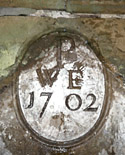 After the eleven years, the rents for land was to be increased by six fold and this is proof of an expectation of
wealth generation from better farming, at least for the few. Only three families remained to continue with farming, the rest are presumed to have departed with the view that Grafton terms were unacceptable, making room for new tenants.
Dorothy Tibbes (widow of Thomas - d. Oct 1660) quit the Manor House which, along with a considerable
total acreage, was rented by the Plowman family. They had refurbished the house by 1702 placing a prominent date-stone over the entrance, see
inset and
After the eleven years, the rents for land was to be increased by six fold and this is proof of an expectation of
wealth generation from better farming, at least for the few. Only three families remained to continue with farming, the rest are presumed to have departed with the view that Grafton terms were unacceptable, making room for new tenants.
Dorothy Tibbes (widow of Thomas - d. Oct 1660) quit the Manor House which, along with a considerable
total acreage, was rented by the Plowman family. They had refurbished the house by 1702 placing a prominent date-stone over the entrance, see
inset and 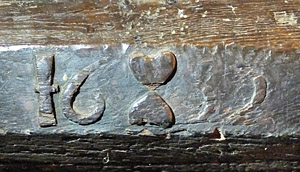 As
a non-professional I did manage to get into some troubles. I was told that
a mantel-beam over a fireplace would be carved, complete, at the builders workshop,
arris chamfer, carved fleur-de-lys and date all done at once while the oak
was relatively green. With a model for Richard Bland's project based
mainly on updating an existing house in Blisworth that he would have
bought in 1650, I served up the alternative scenario where a builder would
leave a 'mesa' of wood on the chamfer to be later carved with a date of
completion - this all premised on a major rebuild. This was the reason for
the quote in reference (4) above that "the date-stone was probably
inserted into the wall of an existing house". Now, with the research
done on what exactly Bland purchased in 1650, ie. land only, we see that the project
was very probably a new build. The date on the chamfer does look as though
it was carved by a less skilled craftsman than whoever finished the
fleur-de-lys - so I claim a perverse point for flexibility whilst someone regrets
listening to me before he wrote his piece....
As
a non-professional I did manage to get into some troubles. I was told that
a mantel-beam over a fireplace would be carved, complete, at the builders workshop,
arris chamfer, carved fleur-de-lys and date all done at once while the oak
was relatively green. With a model for Richard Bland's project based
mainly on updating an existing house in Blisworth that he would have
bought in 1650, I served up the alternative scenario where a builder would
leave a 'mesa' of wood on the chamfer to be later carved with a date of
completion - this all premised on a major rebuild. This was the reason for
the quote in reference (4) above that "the date-stone was probably
inserted into the wall of an existing house". Now, with the research
done on what exactly Bland purchased in 1650, ie. land only, we see that the project
was very probably a new build. The date on the chamfer does look as though
it was carved by a less skilled craftsman than whoever finished the
fleur-de-lys - so I claim a perverse point for flexibility whilst someone regrets
listening to me before he wrote his piece.... 